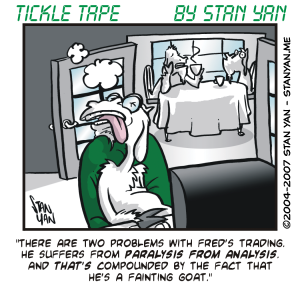Be a rugged individualist. Think independently. Take the contrary position occasionally. Anticipate changes in market conditions, and be ready with alternative plans.” These are common, yet somewhat abstract, themes in investment psychology; each can be illustrated with countless examples in the history of the markets. But let’s try to simplify things for now, and consider a few simple, basic examples, even if they may seem a little oversimplified to some. In our first example, for today’s newsletter, let’s consider the impact of a basic difference in market conditions between that late 1990s and post-2000.
The difference between the way traders approached the markets before and after 2000 illustrates many concepts in investment psychology, but it is a classic example of how market conditions can change, and how with this change, it was even more necessary to think independently and act as a rugged individualist. In several of our Master Interviews, for example, we talked with traders and investors who made seemingly impressive profits before the markets changed in 2000. Back then in the late 1990s, a “profitable” trader didn’t necessarily need to be much of an individualist or take a contrary position.
It seemed as if everyone was trading. You could walk into almost any office in those days and find nearly everyone talking about the huge profits they made in the markets. Optimism was high and the expectation was that the prices were going to go “up, up, up.” These were ideal market conditions, the kind of conditions that draw many into trading (who later find out that it’s harder than they initially thought). In some ways, all one had to do was to pick a stock that the masses thought would go up (such as an Internet company back then) and wait for the price to move upward. And it did, back then, because there were so many new amateur participants entering the markets every day. They were ready to buy, put their money into the markets, and the prices went higher and higher. Simple adages applied in these ideal conditions: “buy high, sell low.
The trend is your friend.” You could actually “follow the crowd” in these conditions. In all likelihood, the price of a popular stock would go up because there were plenty of buyers behind you, ready to buy your stock as the price increased. It was a matter of getting in at a low price and just waiting for the price to go up. You found people, who knew relatively nothing about trading, making substantial profits. Ironically, the “herd instinct” was somewhat useful when so many amateur buyers were willing to invest in the markets. If you were unsure of yourself, you could just wait to see if masses agreed with your hunch, and join them as the price edged up.
Now it wasn’t exactly that easy, but you see the main point: compared to today, all you had to do was find a good indicator that momentum was building, get in early and wait for additional buyers to raise the price, so you could sell at a profit. If only conditions were as ideal today. Today, the “waves” are much shorter, and there are fewer naïve amateurs ready to continue the buying spree once it starts. These days, you need to think more creatively and independently.
In several Master Interviews, our interview candidates tell a familiar story, “I learned to trade in a bull market, and I wrongly thought I knew how to trade.” What they usually say next is that market conditions changed and they quickly found they couldn’t make a dime. When you look at those traders who reported big wins before 2000, you tend to find that many haven’t consistently made very much since. So that’s one common idea addressed: A trading approach may work impressively until the markets change. When they change, one can’t simply follow the crowd or let the “trend be your friend.” It’s not that easy. You’ve got to evaluate the markets from multiple perspectives, rely on your own instincts, and think independently.


